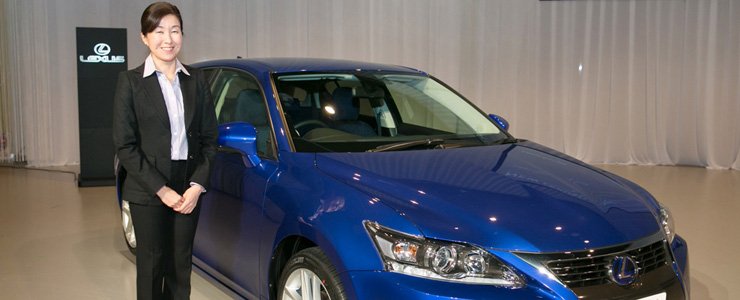A chat with the first female Lexus Chief Engineer
05 Jun 2014|10,124 views
Japanese luxury brand, Lexus, may seem like the typical Japanese carmaker where it's sunk into an integral part of conventional Japan, where it could be deemed unorthodox to have such a ridiculous event like having a female chief engineer.

We aren't exactly scholars of engineering. But before you can sarcastically smack your foreheads and murmur, "You don't say?", we're giving you the next best thing by highlighting Ms. Chika Kako, Chief Engineer of the Lexus CT200h, who is undoubtedly more qualified than us in the engineering department.
Having worked with Toyota Motor Corporation for over 12 years, Ms. Chika Kako was assigned to the job in June 2012. She brings to the table an extensive experience within Toyota and Lexus, including work on the RX and IS model ranges, proving that you can indeed juggle the household chores and get your hands dirty with some serious talent on the side.
SGCM: Former CT Chief Engineer Osamu Sadakata set the bar high with the previous CT200h. How challenging was it using him as a benchmark?
CK: Thanks to Chief Engineer Sadakata, the CT was already very popular, because of its sporty handling and great fuel consumption. In the 2014 model, we tried to enhance the model. He produced a great vehicle and it has been an honour to develop this new model.
 |
SGCM: What were the main issues that customers had with the previous CT200h and how have you ensured that the new car is better to drive than before?

Taking their feedback into account, more than 90 enhancements were included in the 2014 model for a better driving experience - reducing noise, vibration and harshness (NVH).
SGCM: What aspects of the car's development did you find especially challenging?
CK: It would have to be enhancing the car's body rigidity, while improving both handling and ride comfort.
SGCM: Do you think the target audience for the CT200h has shifted? If so, what do you think is the main focus of the new car?
CK: I don't think it has changed. I would recommend the CT200h to people who want to have a luxury compact vehicle.
SGCM: We get the perception that Japanese women in the working force aren't treated as importantly as men. Could you briefly tell us about your experience, as a woman, leading this project?
CK: I can't speak for the rest of Japan, but for me personally, I didn't focus on overcoming these challenges in this industry. My focus was on trying to do what I believe is most important for me. That is how I came to be a Chief Engineer for Lexus.
Japanese luxury brand, Lexus, may seem like the typical Japanese carmaker where it's sunk into an integral part of conventional Japan, where it could be deemed unorthodox to have such a ridiculous event like having a female chief engineer.

We aren't exactly scholars of engineering. But before you can sarcastically smack your foreheads and murmur, "You don't say?", we're giving you the next best thing by highlighting Ms. Chika Kako, Chief Engineer of the Lexus CT200h, who is undoubtedly more qualified than us in the engineering department.
Having worked with Toyota Motor Corporation for over 12 years, Ms. Chika Kako was assigned to the job in June 2012. She brings to the table an extensive experience within Toyota and Lexus, including work on the RX and IS model ranges, proving that you can indeed juggle the household chores and get your hands dirty with some serious talent on the side.
SGCM: Former CT Chief Engineer Osamu Sadakata set the bar high with the previous CT200h. How challenging was it using him as a benchmark?
CK: Thanks to Chief Engineer Sadakata, the CT was already very popular, because of its sporty handling and great fuel consumption. In the 2014 model, we tried to enhance the model. He produced a great vehicle and it has been an honour to develop this new model.
SGCM: What were the main issues that customers had with the previous CT200h and how have you ensured that the new car is better to drive than before?

CK: The CT was very quiet due to the hybrid engine and most customers expected this to continue even during full acceleration.
Taking their feedback into account, more than 90 enhancements were included in the 2014 model for a better driving experience - reducing noise, vibration and harshness (NVH).
SGCM: What aspects of the car's development did you find especially challenging?
CK: It would have to be enhancing the car's body rigidity, while improving both handling and ride comfort.
SGCM: Do you think the target audience for the CT200h has shifted? If so, what do you think is the main focus of the new car?
CK: I don't think it has changed. I would recommend the CT200h to people who want to have a luxury compact vehicle.
SGCM: We get the perception that Japanese women in the working force aren't treated as importantly as men. Could you briefly tell us about your experience, as a woman, leading this project?
CK: I can't speak for the rest of Japan, but for me personally, I didn't focus on overcoming these challenges in this industry. My focus was on trying to do what I believe is most important for me. That is how I came to be a Chief Engineer for Lexus.
Thank You For Your Subscription.




















